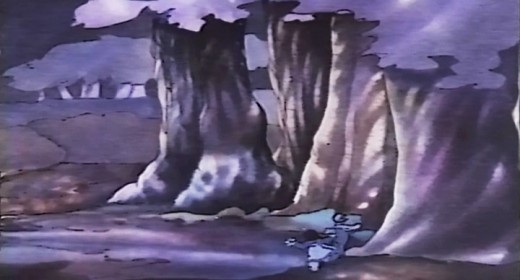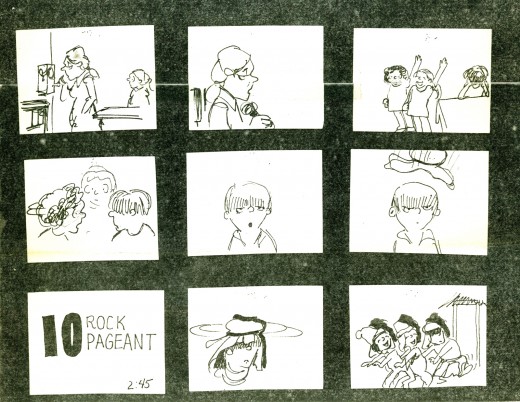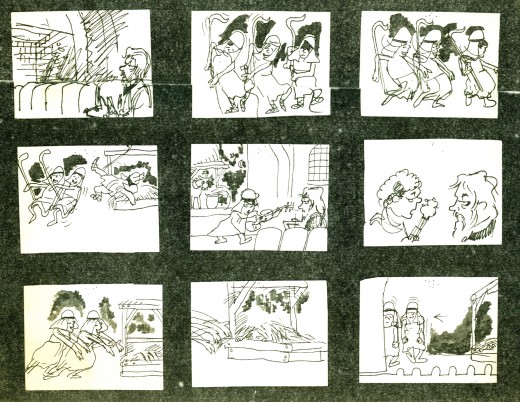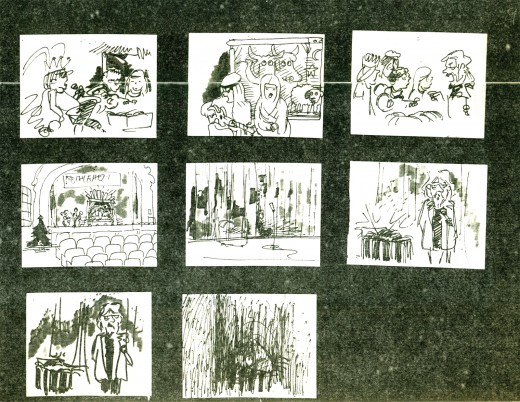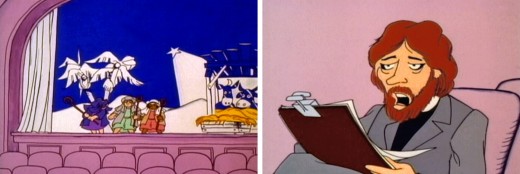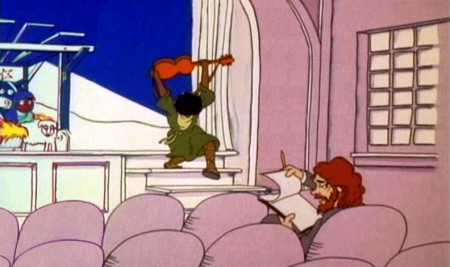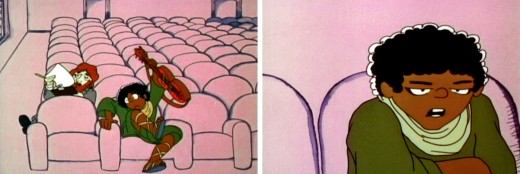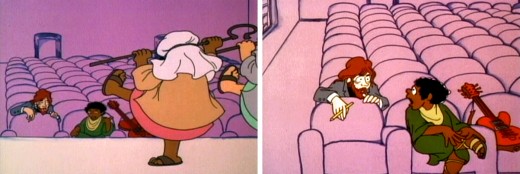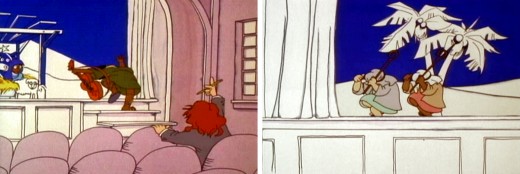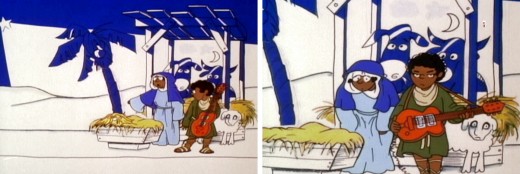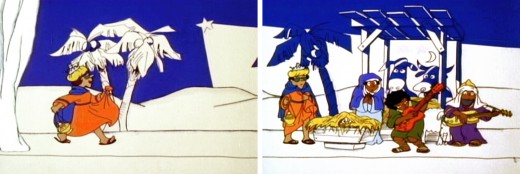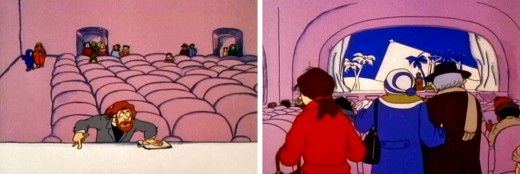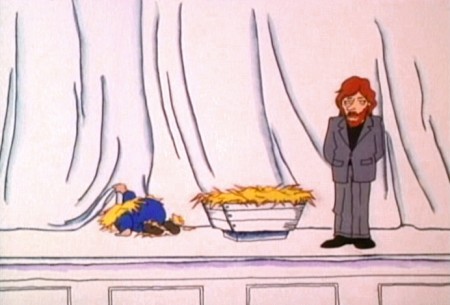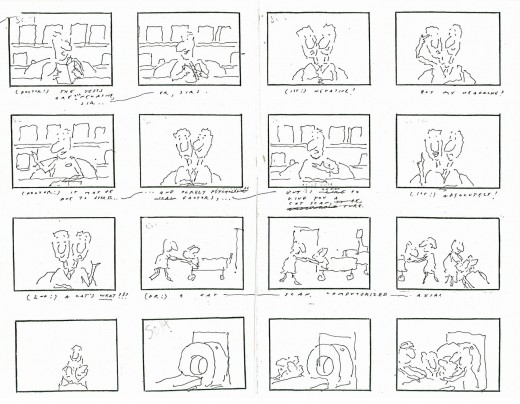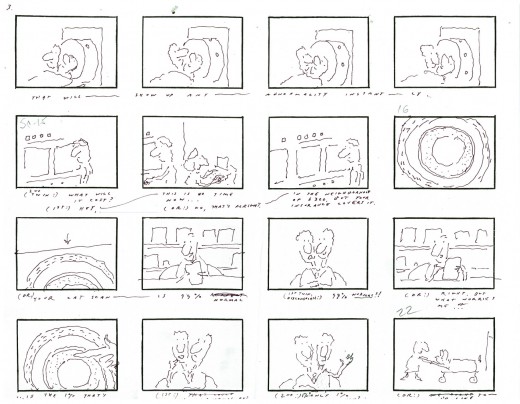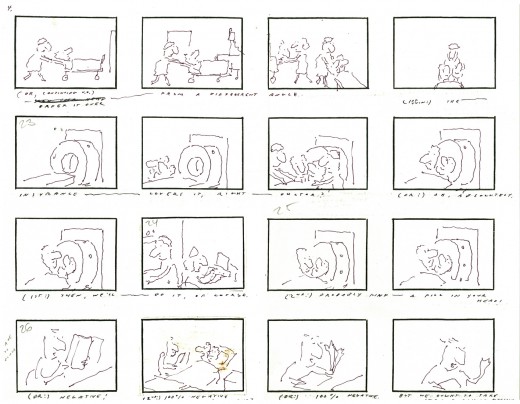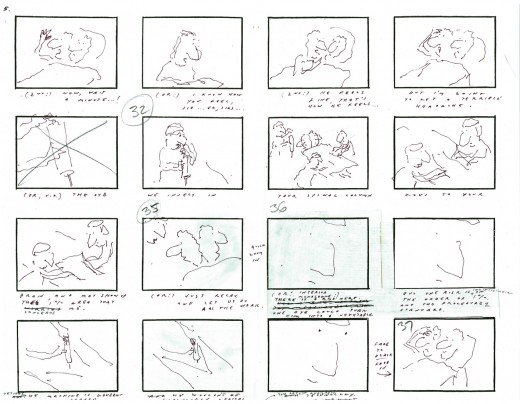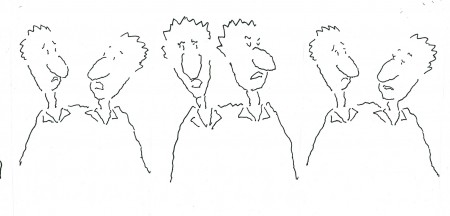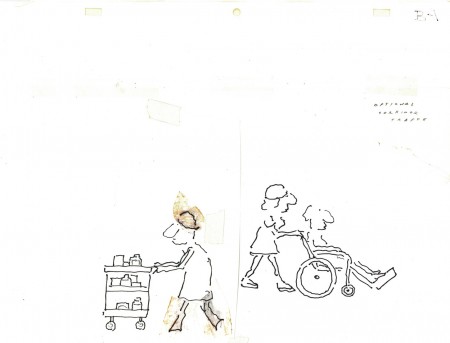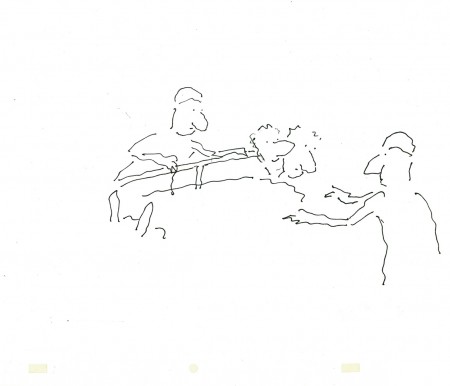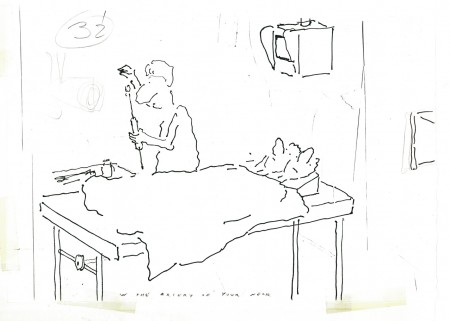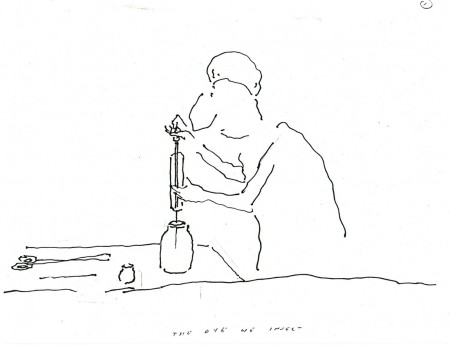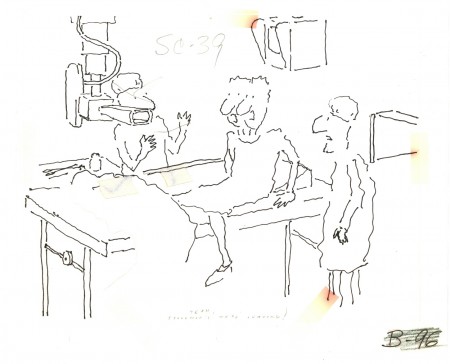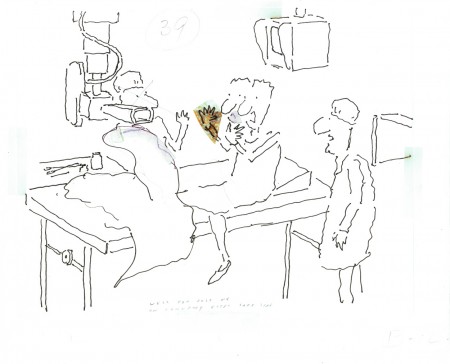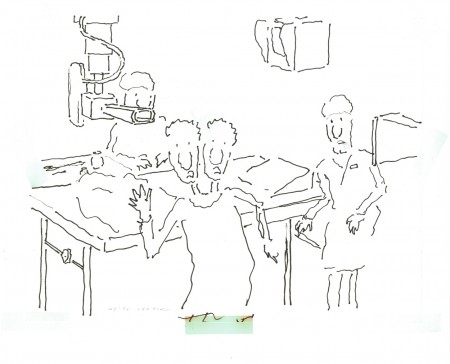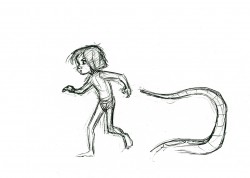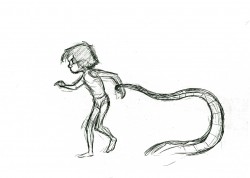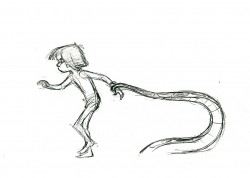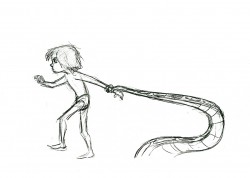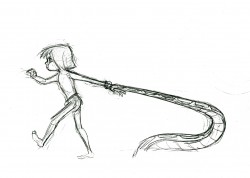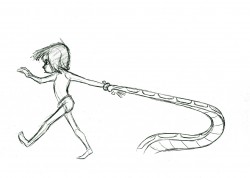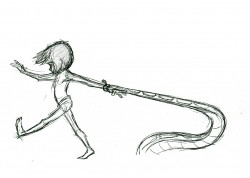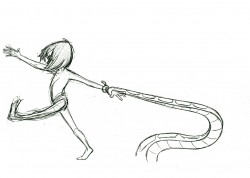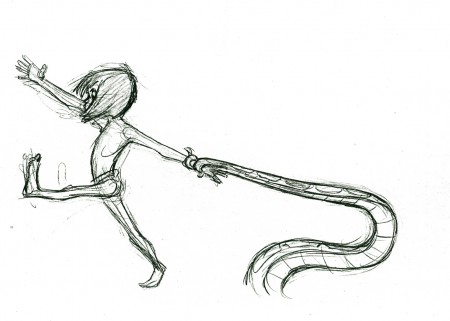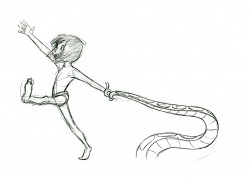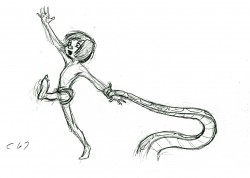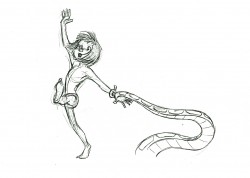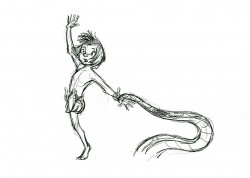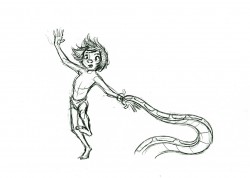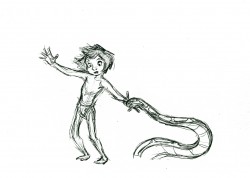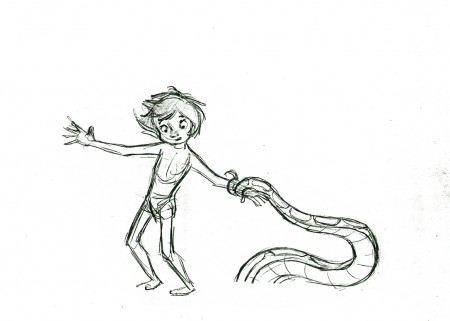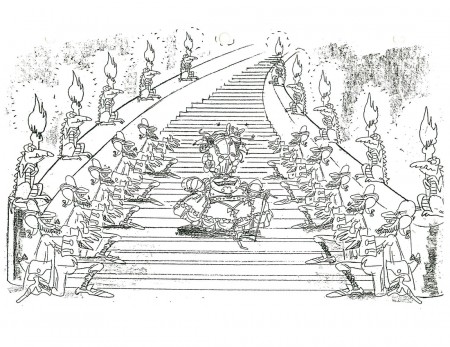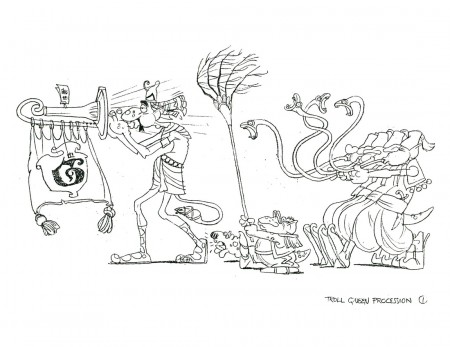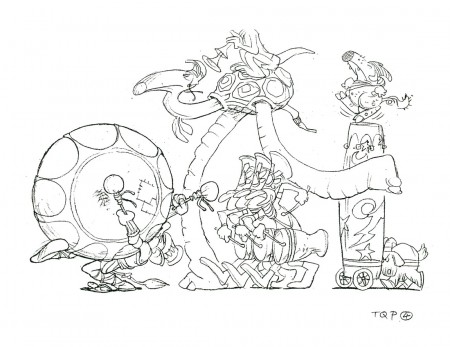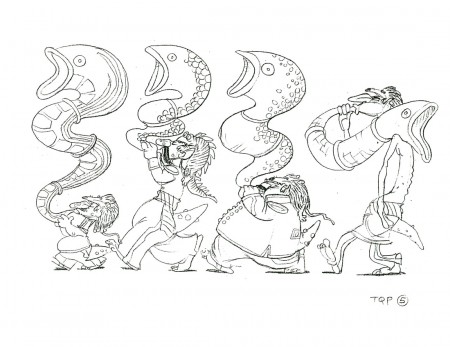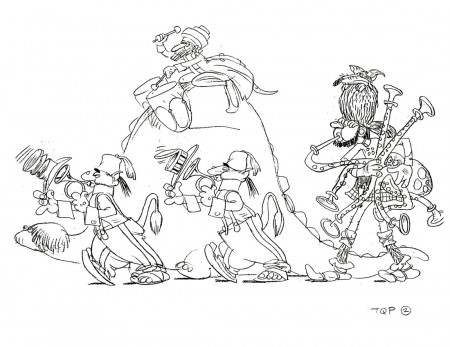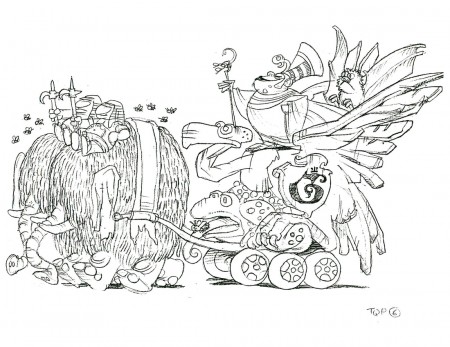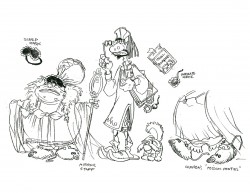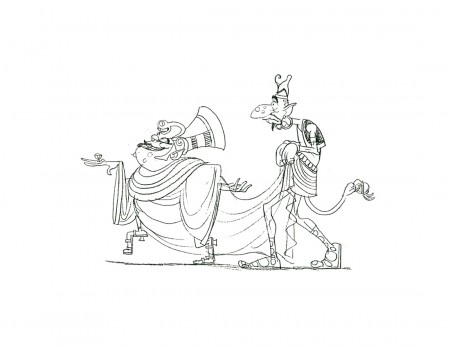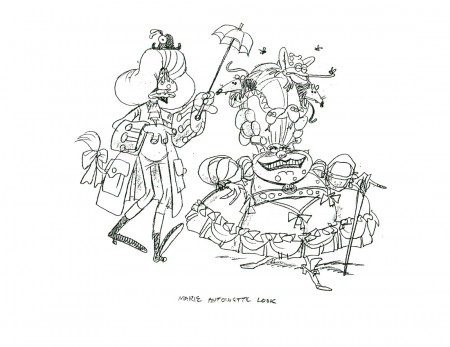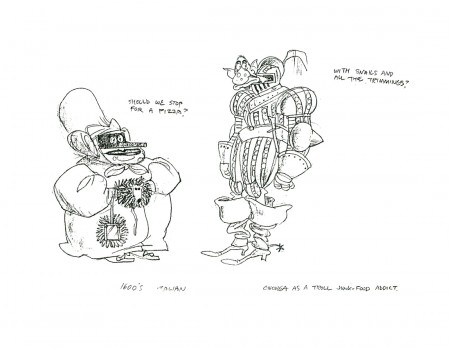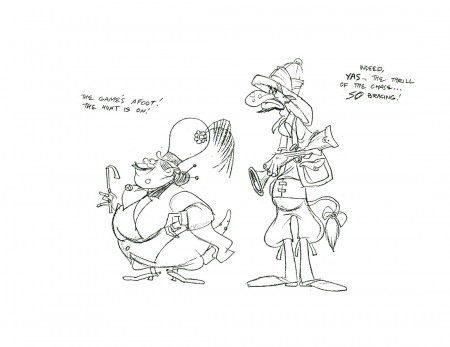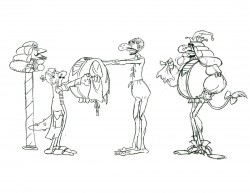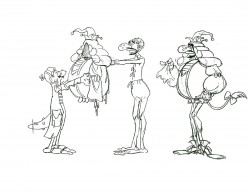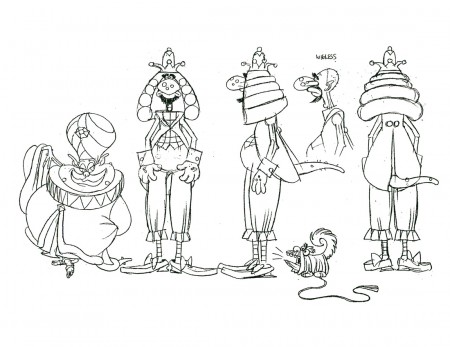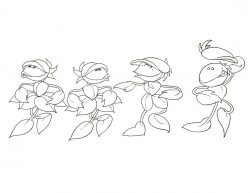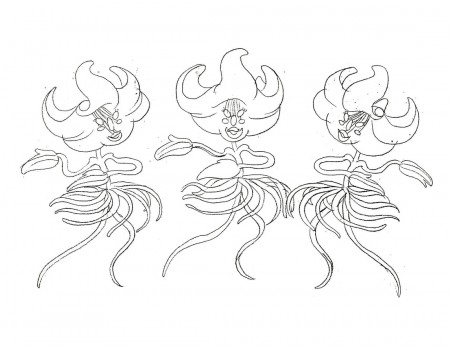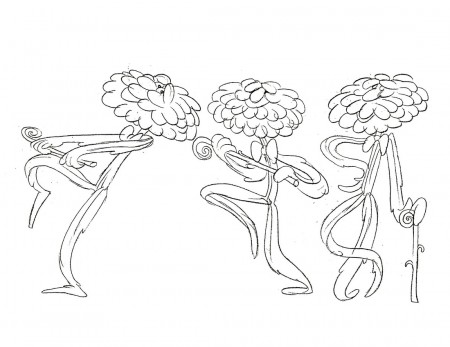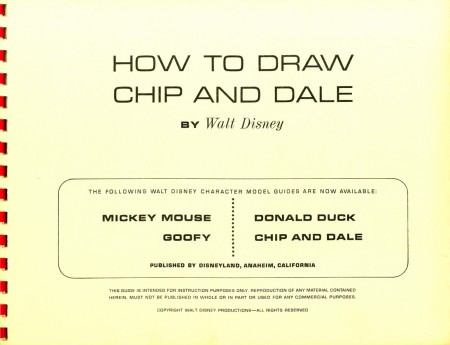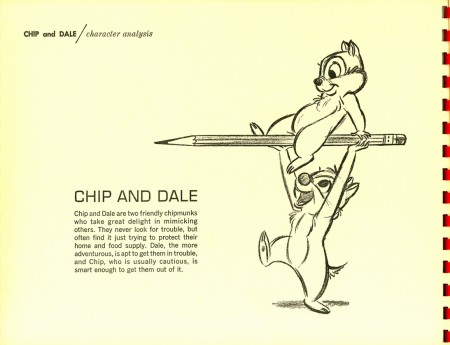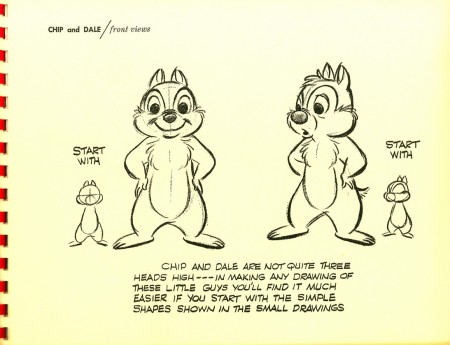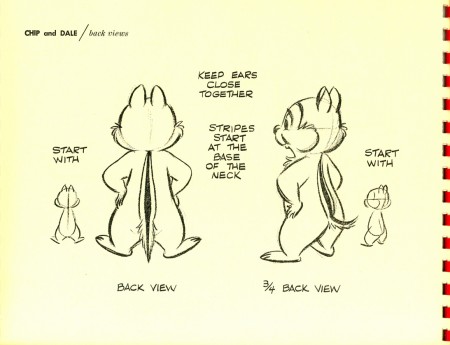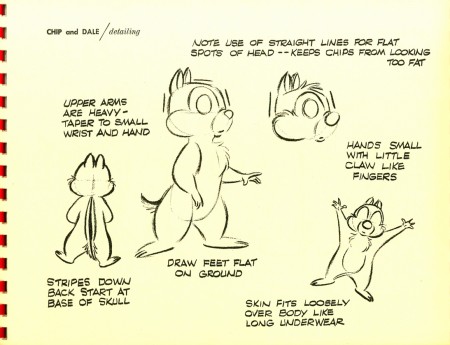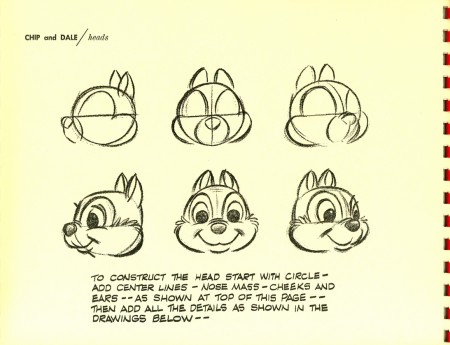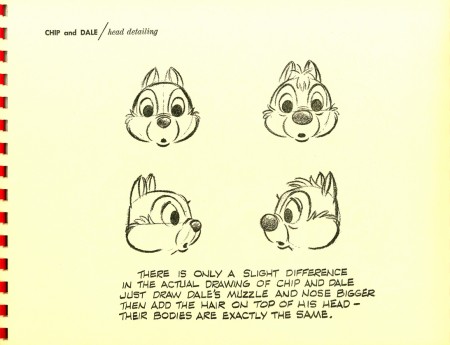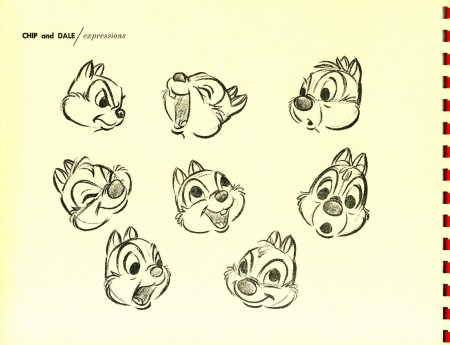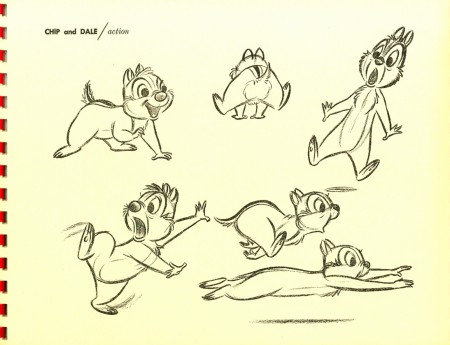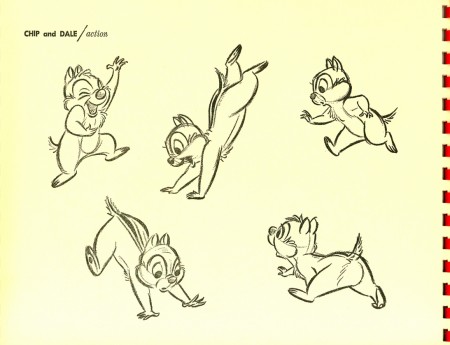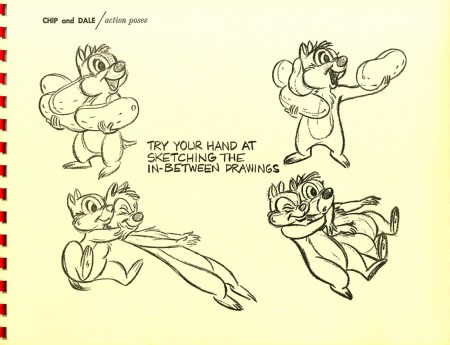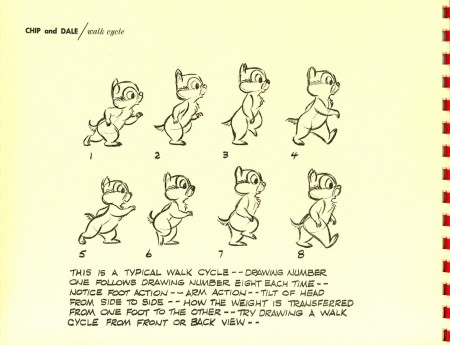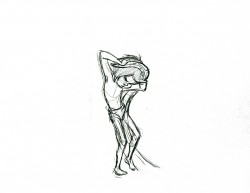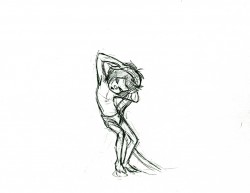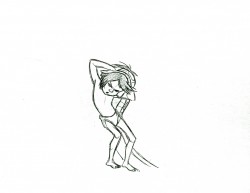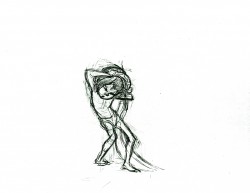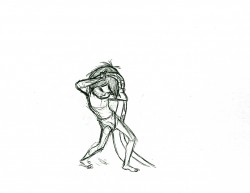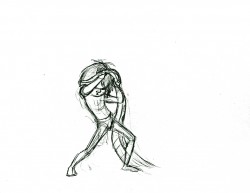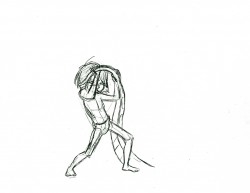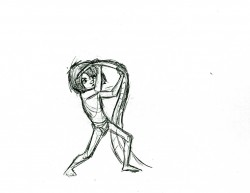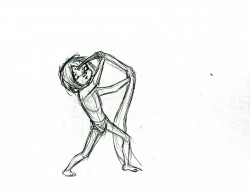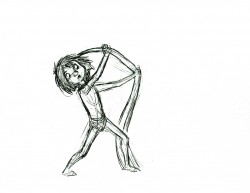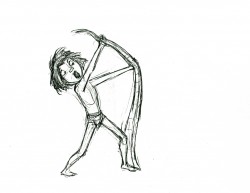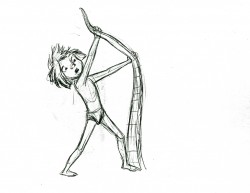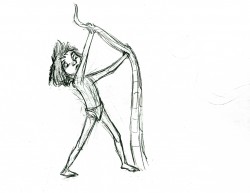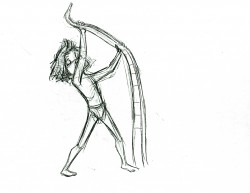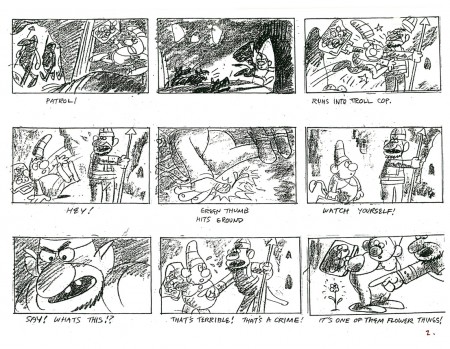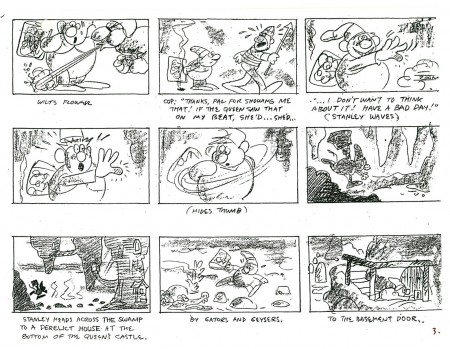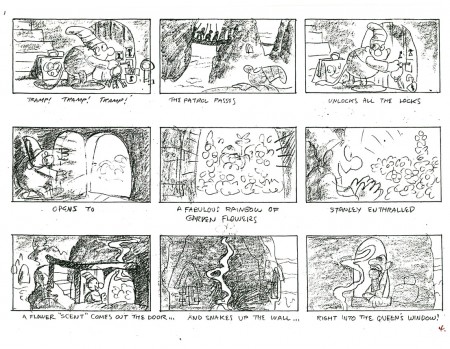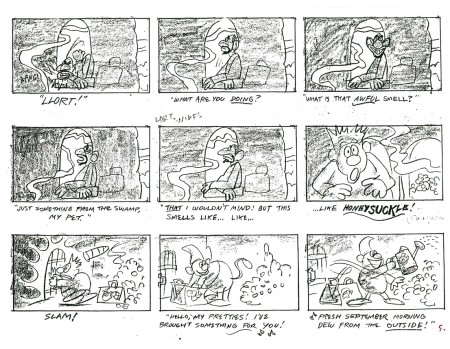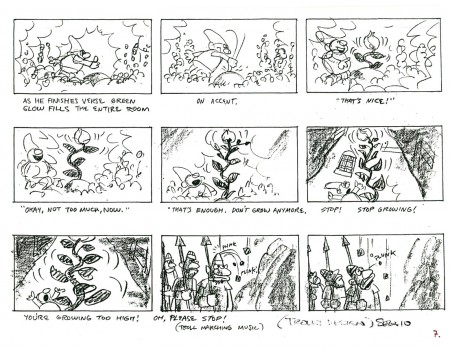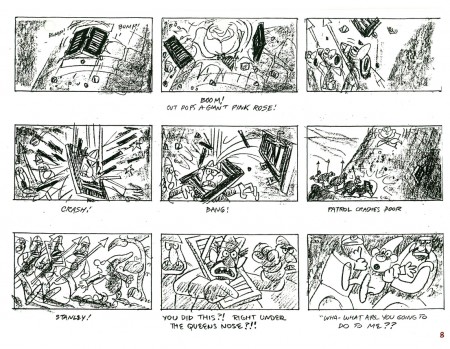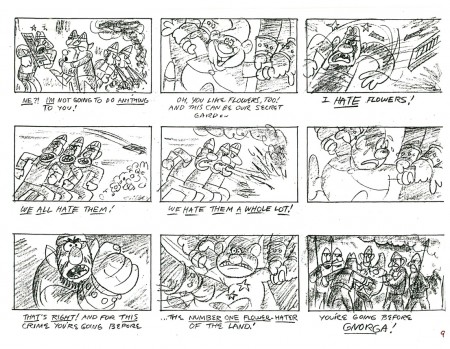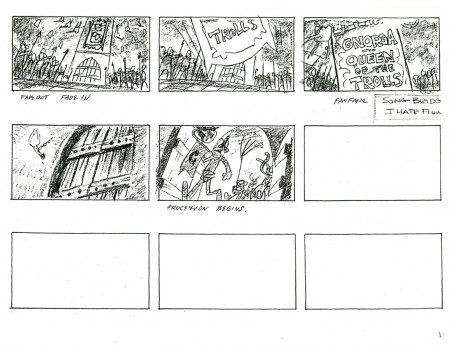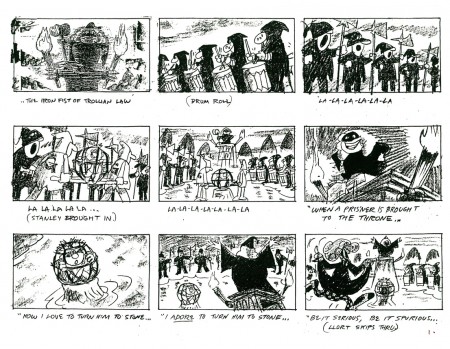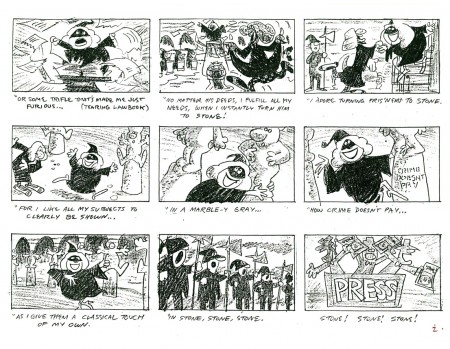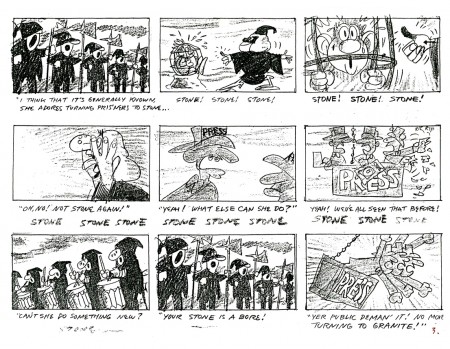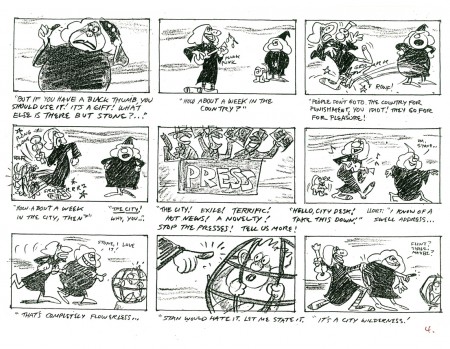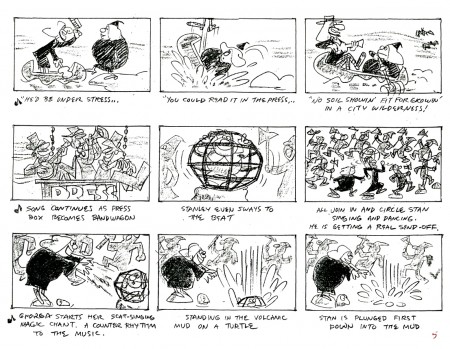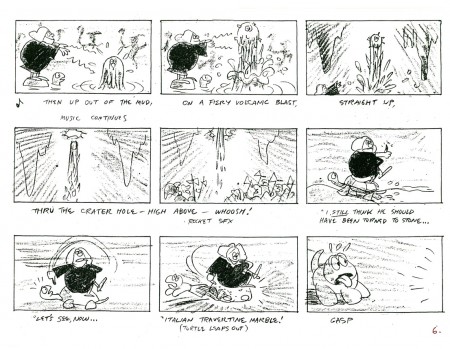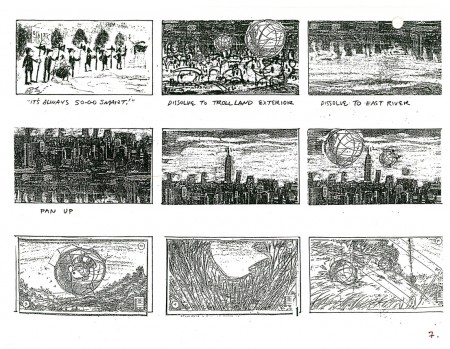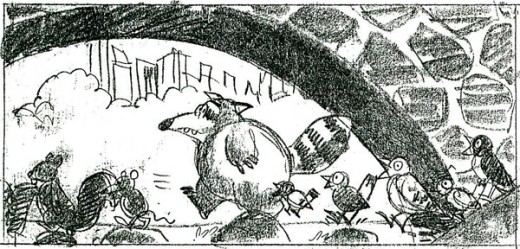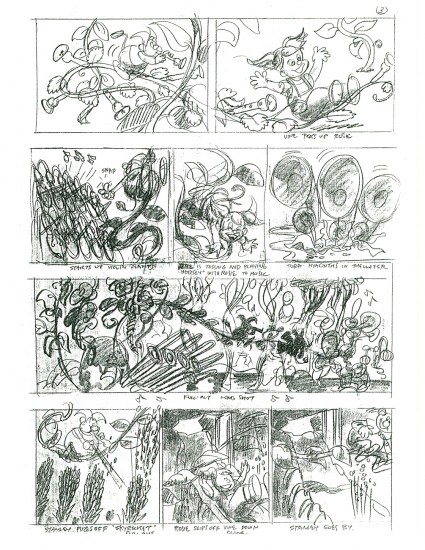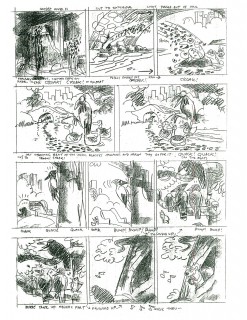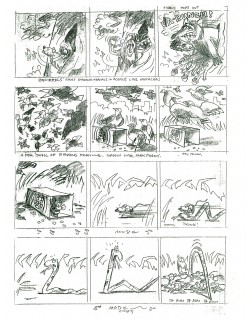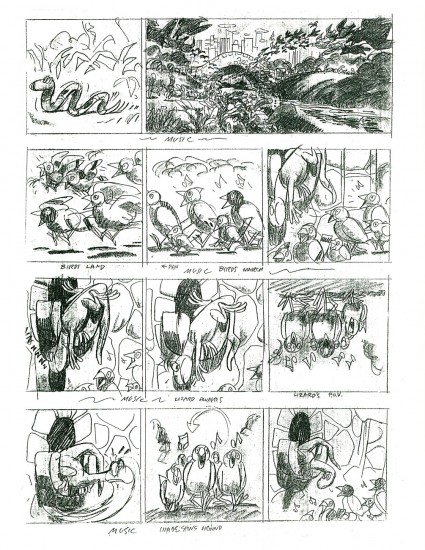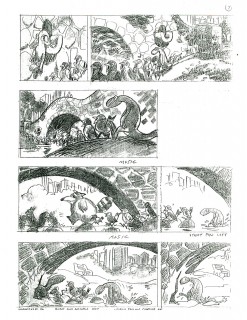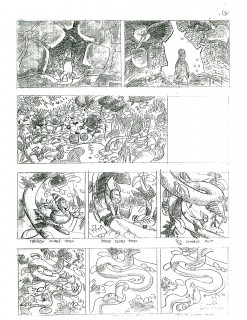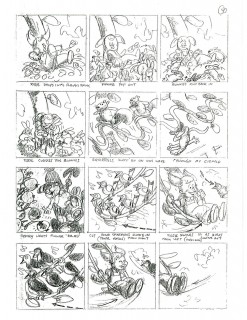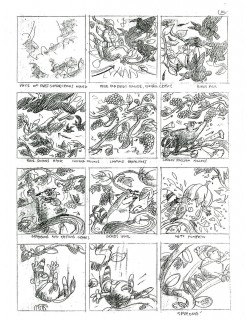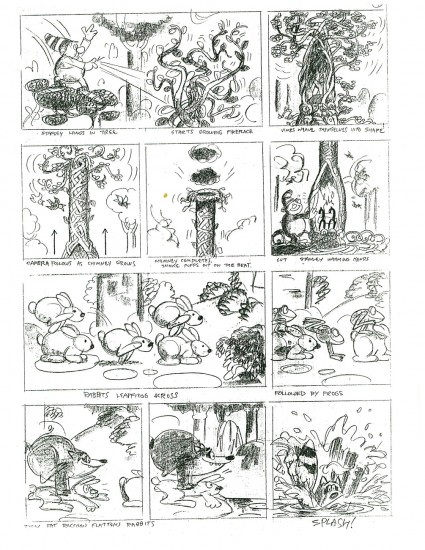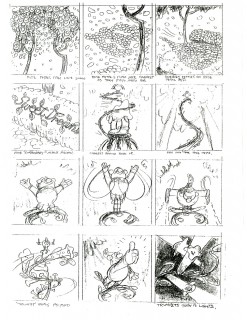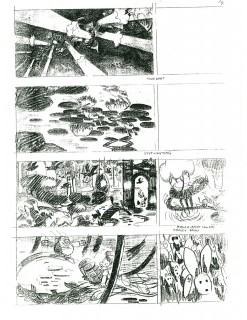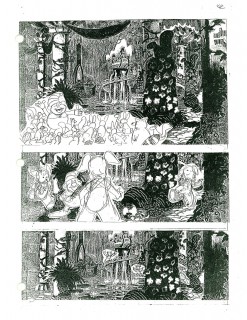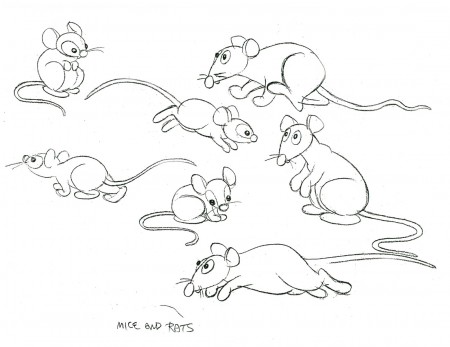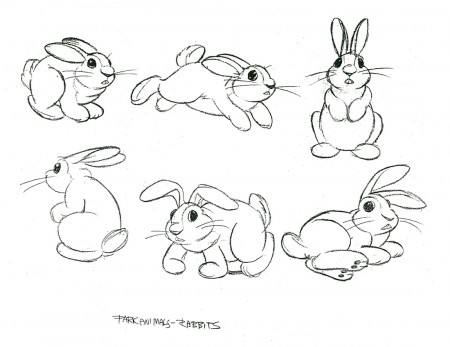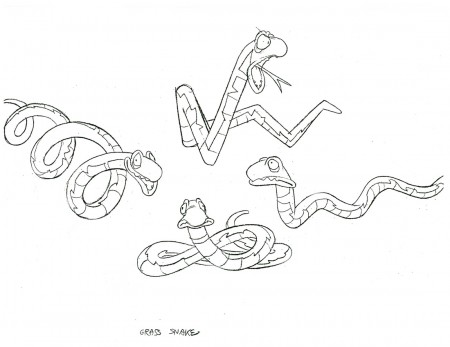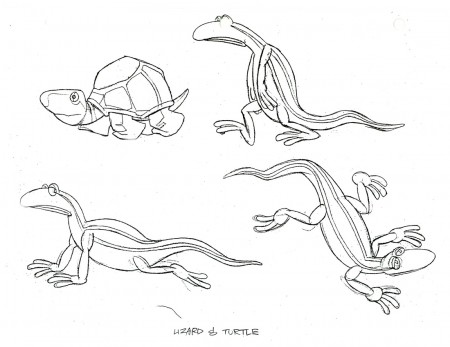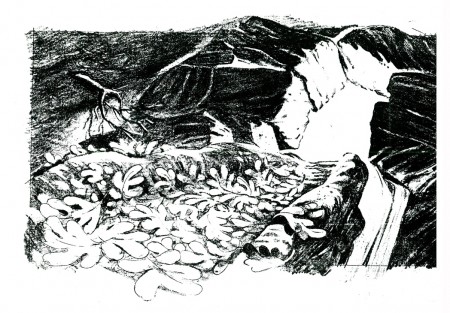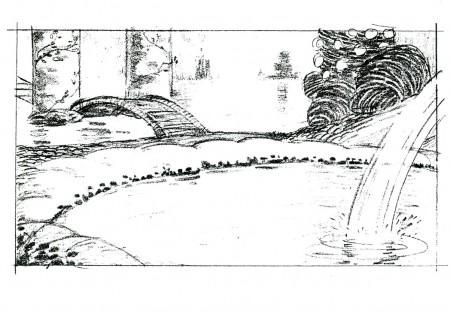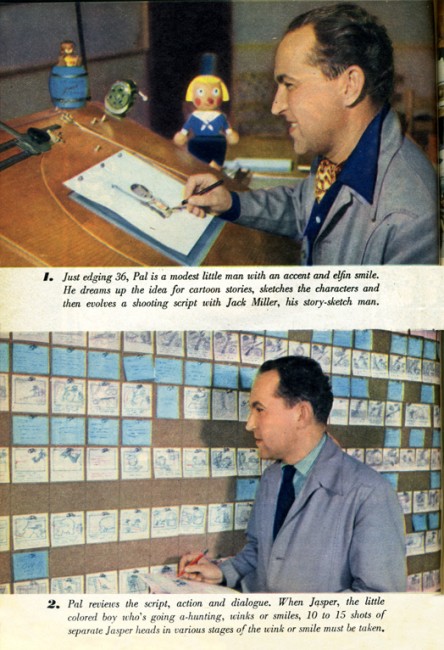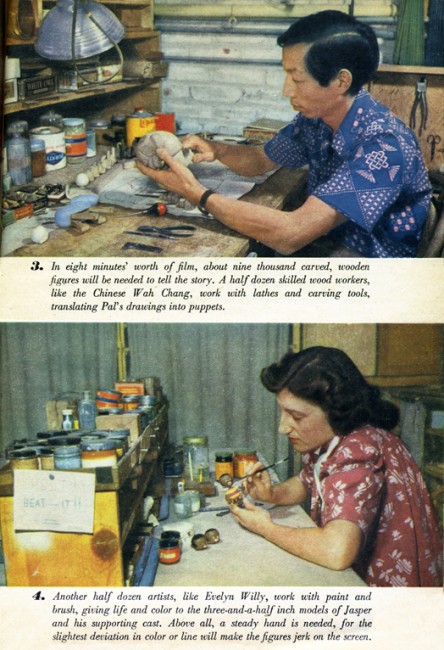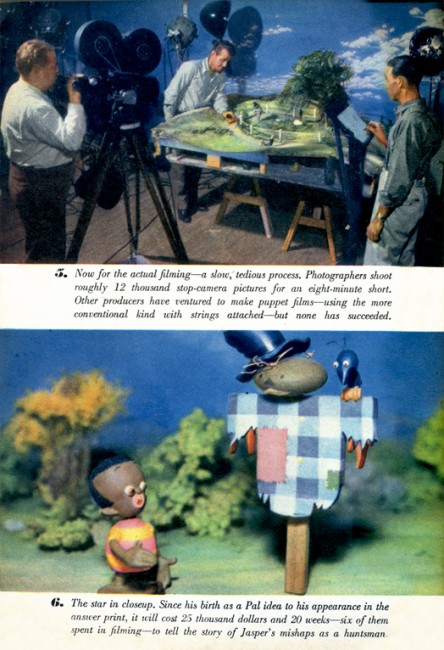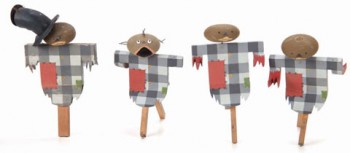Category ArchiveAnimation Artifacts
Animation &Animation Artifacts &walk cycle 12 Nov 2009 08:31 am
Tissa’s Ann Run
- Here’s a run Tissa David did for Raggedy Ann. The character is tiny in the frame. The entire scene is more than 45 secs long (no cuts); this run comes toward the end of it.
Tissa had the character run across two fields of paper, and animated a slight move of the background underneath her. Consequently, it feels as if she’s slipping in place a bit. However, if you see it in the film, you’ll see that she looks anchored to the BG.
 455
455If you click any drawing the actual animation sized paper will pop up.
 456
456
You’ll note that Tissa worked on standard animation paper – 10½ x 12½.
When Ann runs off the edge of one field, she pops to the other edge
of the next field. It saved having to work on 2 field paper.
Click left side of the black bar to play.
Right side to watch single frame.
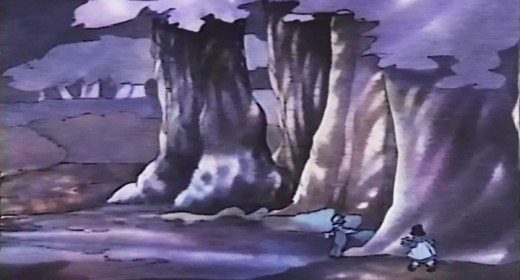
These are the first and last frames of this walk taken from the actual film.
It’ll give you an idea of how tiny they are in the frame, yet how large they were drawn.
David Nethery, in the comments section, left a link to a QT movie of this scene. You should read David’s excellent comment and check out the scene in motion.
Animation Artifacts &Hubley &Story & Storyboards 09 Nov 2009 08:40 am
Doonesbury Start
- Today it’s back to the Doonesbury well. Tissa David was brought on to do the sequence where the kids put on the Christmas pageant. Through these materials we can see how the sequence takes shape even before the animator/director gets to do any character posing.
She, of course, was given the script as well as the original voice track for the sequence. These are the pages for the sequence:
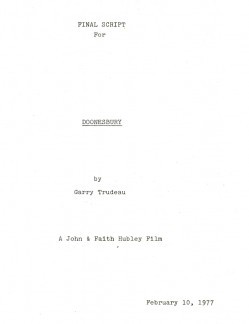 Cov
Cov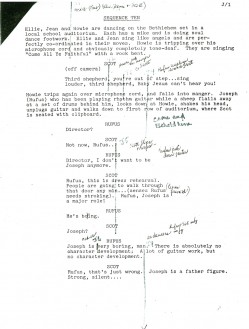 J1
J1(Click any image on this post to enlarge.)
.
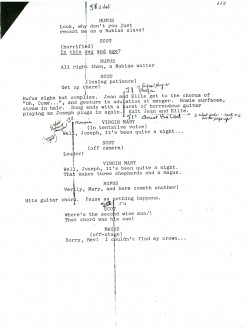 J2
J2 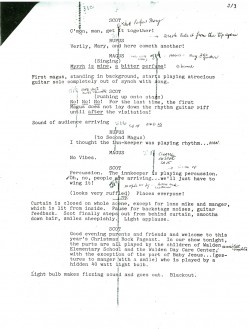 J3
J3Tissa also had a copy of the storyboard that John Hubley and Garry Trudeau did for the film. (Note that there’s no dialogue indicated. This is the way John and Faith worked. They’d memorized the track by the time they did the board.)
Tissa then took a bunch of specific frames from the board and blew them up. With these she decorated her walls all around her drawing table.
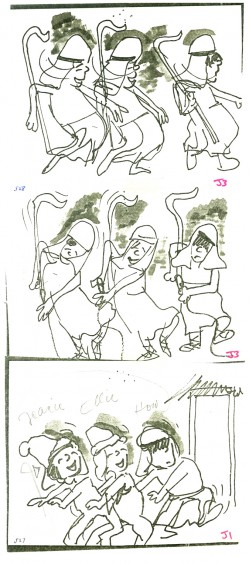
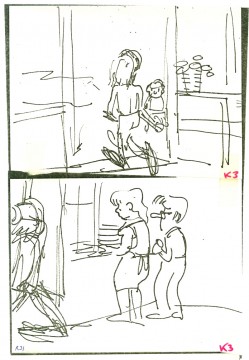
These drawings weren’t so much to act as models but as inspiration.
She plucked them from many different parts of the board even ones
that she did not work on.
.
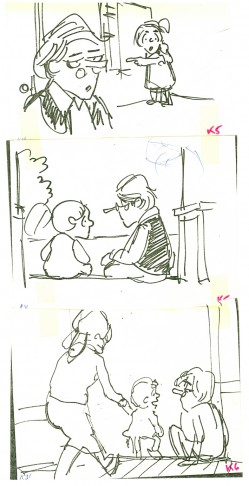

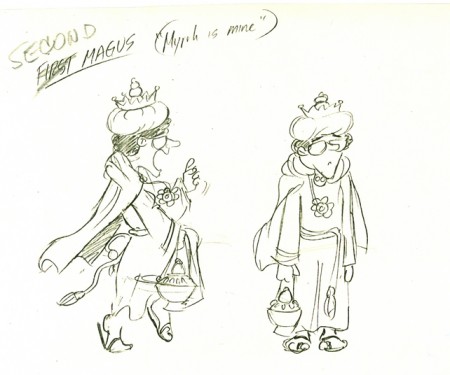
Here’s a drawing by Garry Trudeau that hung with the others.
Then, Tissa did her own board. She modified the scene arrangement and cutting. She always did this with John’s boards. He trusted her implicitly and gave her free reign to alter.
I only once saw them disagree about a scene – it was more about how it should be drawn. John won. he was the director.
This rough board Tissa did was only for herself. The drawing was quick and rough, and the images were small.
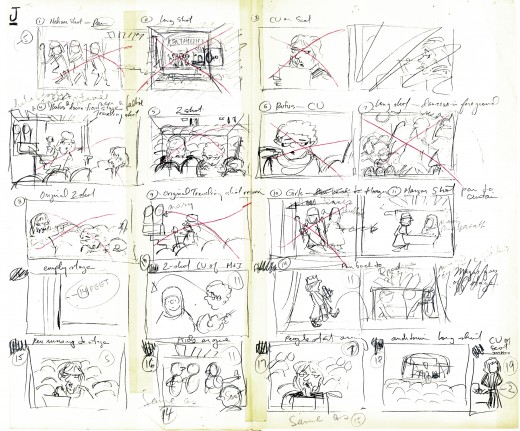
Finally, here are frame grabs from the actual sequence. Sorry, the colors are all over the place. The transfer is soft, and the colors never remain true.
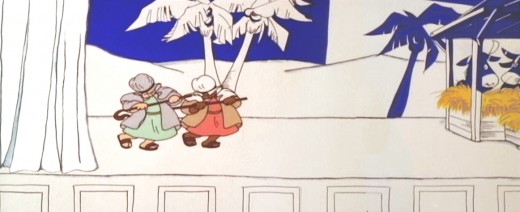 J1
J1
Animation &Animation Artifacts &Story & Storyboards 02 Nov 2009 08:25 am
Medical Dilemma
- One of the best, most intelligent films I worked on was a short film R.O.Blechman made for NBC television. The network was doing a three hour evening dedicated to the state of health care and hospitals in America. They wanted Bob to make a film about over-testing to find things to resolve a patient’s complaints.
Bob and I made numerous trips to Columbia Presbyterian Hospital to get information about procedures for testing the brain. This was back in 1977. CATscan tests were just then starting to come into their own. It wasn’t as frequently used as it is now. Other tests were demonstrated for us, and we spent several days watching these exams being done. Dyes being injected into the brain, machines that turned the patient upside-down, lots of big-named procedures
Bob wrote a piece about a set of siamese twins – a man with two heads. The two heads kept a running discussion about a headache one of them had. They went to a doctor who decided to do some basic tests. They discovered nothing. More tests – nothing. Finally, the doctor wants to try one more test. The twins see the needle and get off the table. They refuse this final test. The two heads join into one.
The doctor, in cu, starts to talk to himself, aloud. His head splits into four different opinions discussing the situation, and the film ends.
Here’s Bob Blechman’s storyboard for the film.
 1
1(Click any image to enlarge.)
The whole film, about four minutes, had fewer than four months from beginning to end. The board went through lots of changes on the fly as the animators worked. Tissa David and Ed Smith were the primary animators on this film, although Ed did the scene I most think about within the film. The third and last animator on was Cosmo Anzilotti. I assisted all of them in whatever their needs – clean-up, inbetween or inking.
There was at least one scene of genius in this movie.
That final cu at the end of the board where you see the face of the doctor fill the screen – it animates in on him – all lines, just lines, that completely told that doctor’s thoughts and mindset. Lines on the screen that you completely bought as a face. A face with multiple voices and personalities arguing with itself. It was brilliant and remains one of my all time favorite bits of animation.
The voice of the twins was done brilliantly by the late, great Anthony Edwards. He was the perfect voice for the Blechman character, and he did quite a few of them over the years. This was one of his finest performances for Bob.
Here are some of Tissa’s drawings and layouts:
 1
1This collection of drawings stood over Tissa’s desk while she animated.
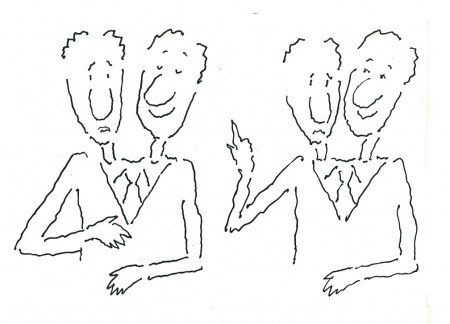 a
a
Here, I’ve broken that long piece into three smaller.
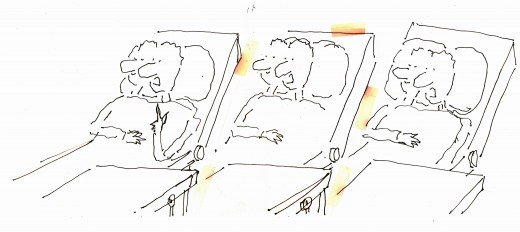 2
2
This is another drawing from above her desk.
The yellowing is the tape that held the drawings together.
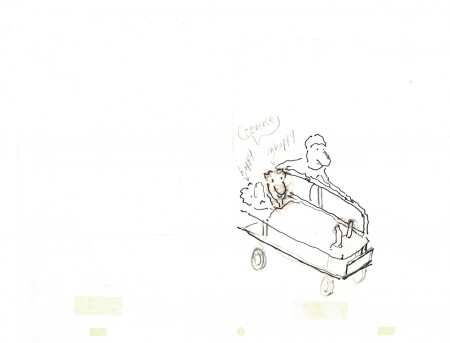 3
3
The twins being wheeled to their exam.
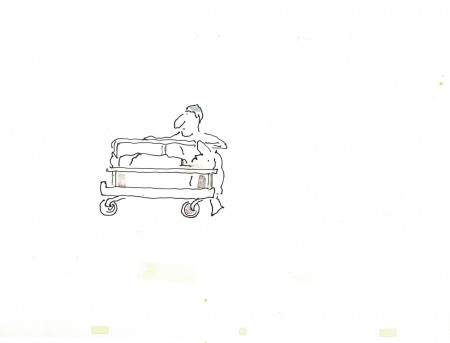 4
4
Passing gurneys in the hospital hall.
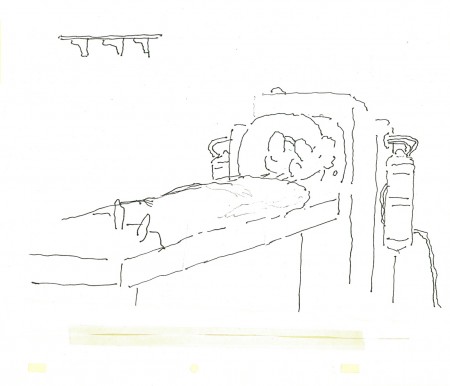 6
6
Here the twins are about to face a CATscan.
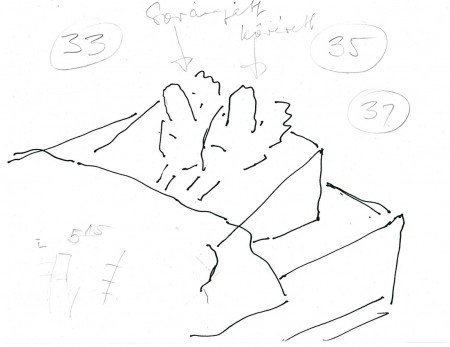 8
8
The patients questioning the final test.
I don’t know how you’d get to see this film, but I hope it shows up sometime. I have a 16mm copy, but I haven’t transferred it. Maybe I’ll ask Bob for a copy of it.
Animation &Animation Artifacts &Disney 19 Oct 2009 07:37 am
Frank Thomas’ Jungle Book 3
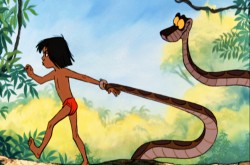 - This is the last of three posts showcasing the drawings of Frank Thomas for one scene of Mowgli and Kaa in The Jungle Book.
- This is the last of three posts showcasing the drawings of Frank Thomas for one scene of Mowgli and Kaa in The Jungle Book.
Frank was a very productive animator who was very defensive of his drawing ability, yet he always seemed to come up with something attractive and full of his gentle personality.
There is some nice use of foreshortening in the leg of Mowgli in these drawings. You have to be particularly good at drawing to make it work; I think I’ve seen too many bad drawings where it’s called attention to itself. Foreshortening is usually something worth avoiding unless you feel really confident about it. However, as done by Frank, it really helps the motion.
Again there is a smart use of ones and twos, and there seems to be no effort in having moved back and forth between the two. Yet, when you look at the movement, it seems natural.
The scene also ends in the middle of an action, something an editor might do, but it seems to be controlled by the animator here.
The entire scene is now up in all of the QT’s posted.
Part 1
Part 2
We start with the last drawing from Part 2.
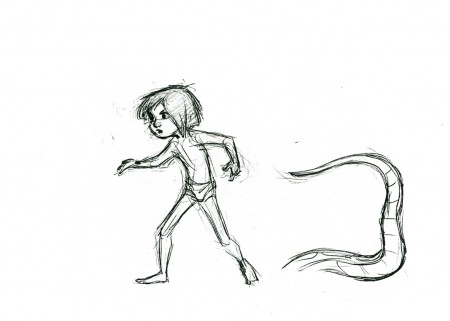 51
51(Click any image to enlarge to full animation sheet size.)
The QT movie below includes Parta 1, 2 &3 of this scene.
Mowgli & KaaClick left side of the black bar to play.
Right side to watch single frame.
Many thanks to John Canemaker for sharing these drawings with us.
Animation Artifacts &Bill Peckmann &Models &Rowland B. Wilson 09 Oct 2009 07:42 am
more Troll models
- The Rowland Wilson storyboard sequence from Don Bluth’s A Troll in Central Park, which I posted yesterday, had lots of interesting bits. This is made more evident by the number of great models Rowland did for the sequence. Thanks to Bill Peckmann‘s collection, there are many of these to post, and I think you’ll find them interesting. They’re what you want in a model; they excite interest in animating those characters. At least, that would be the case for me.
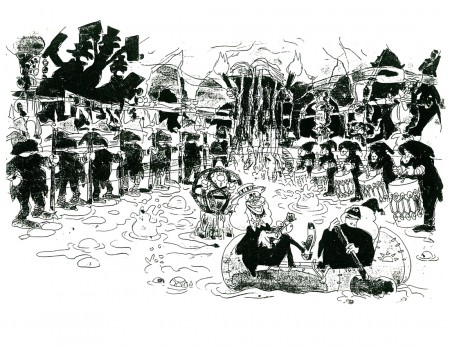 1
1(Click any image to enlarge.)
Here, additionally, are more anmial and plant character models for the film.
 18
18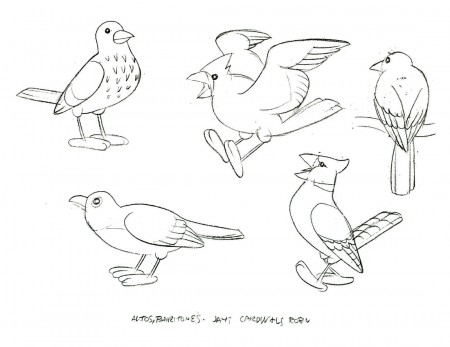 19
19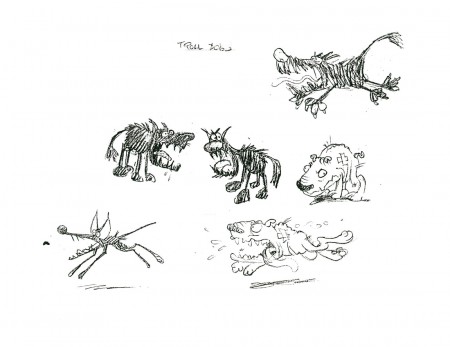 20
20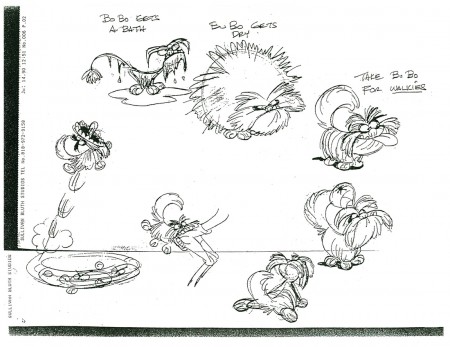 21
21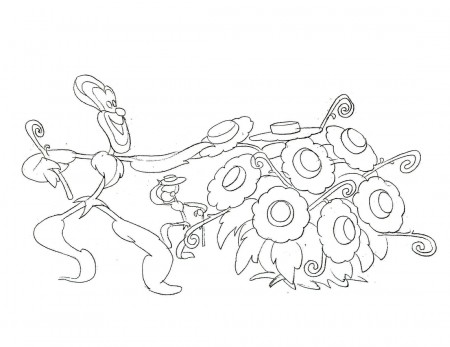 22
22
Once again, many thanks to the gracious Bill Peckmann for the loan of Rowland Wilson‘s work. I’m a big fan, and it’s a pleasure to even veiw these models never mind post them.
Animation Artifacts &Bill Peckmann &Books &Disney &walk cycle 08 Oct 2009 08:28 am
How To Draw Chip & Dale
- In the past I’ve posted the series of booklets that Disney released via the Art Corner at Disneyland. How To Draw Mickey, Donald, Goofy and Pluto have been posted. The only one left is How To Draw Chip & Dale. Thanks to Bill Peckmann, I can post this last booklet.
The past booklets I posted were actually rereleased publications that were stapled together and handed out at the Lincoln Center celebration for all things Disney back in 1973.
This Chip & Dale book, however, is the real thing. It was an original published in 1955.
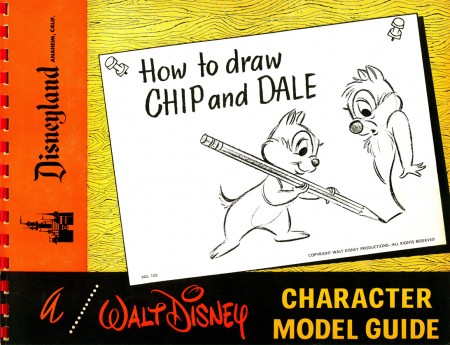 1
1(Click any image to enlarge.)
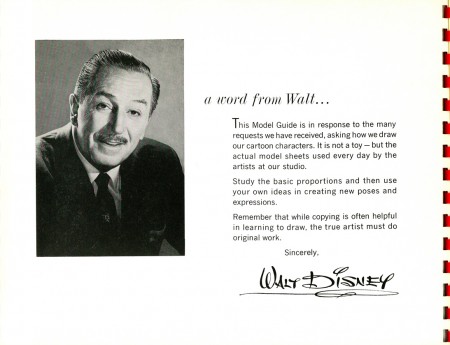 2
2
This is the inner cover which iss a thin cardboard.
as opposed to the yellow pages of paper.
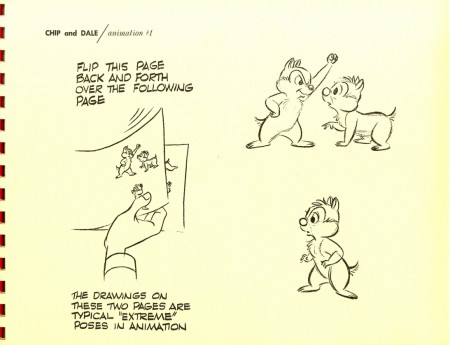 15
15
The directions tell you to flip the pages to see the movement.
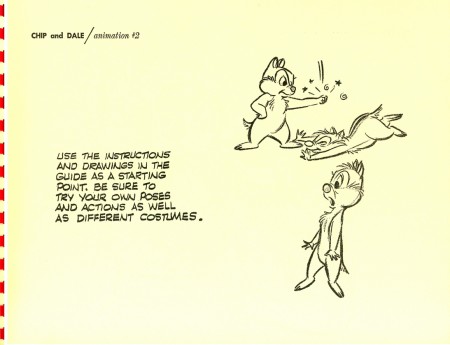 16
16
However this page is printed on the back of page 15,
and it’s impossible to flip. It doesn’t matter since the two drawings
aren’t registered to each other and flipping doesn’t work.
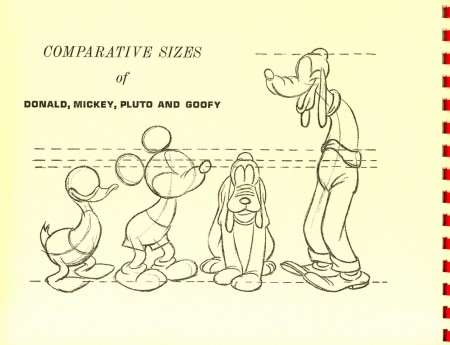 18
18
This page appears in all of the booklets.
Here’s a QT of the walk cycle on pg 12.
Chip cycle on threes.
Click left side of the black bar to play.
Right side to watch single frame.
Go here to see the lecture series posts:
Mickey / Donald / Goofy / Pluto
Here to see How To Draw Mickey.
Here to see How To Draw Donald.
Here to see How To Draw Pluto.
Here to see How To Draw Goofy (Jenny Lerew‘s Blackwing Diaries.)
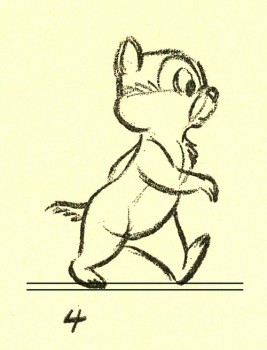
I once pointed out that a good walk should be drawn
with the two feet a distance apart from each other.
This creates a sense of depth in that walk. You might look
for this when you see other walks on line. You’ll be
surprised at how many professionals do it and how many
beginners don’t. Lately the latter is beating the former.
Animation &Animation Artifacts &Disney 05 Oct 2009 08:29 am
Frank Thomas’ Jungle Book 1
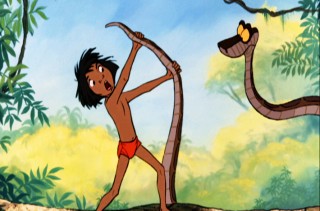 John Canemaker has loaned me a scene of drawings by Frank Thomas from the Jungle Book. Actually, they’re not the actual drawings but s/s xeroxed copies.
John Canemaker has loaned me a scene of drawings by Frank Thomas from the Jungle Book. Actually, they’re not the actual drawings but s/s xeroxed copies.
75 drawings in all, I’m going to post this scene between Mowgli and Kaa, the snake, however, I’ll have to break it up into a couple of posts. Here’s the first part, and I’ll follow up next Monday with more. Eventually we’ll post them all and have a QT movie of the full scene.
I’m not a fan of this film, however, I can’t deny the animation is mostly excellent and sometimes brilliant. Needless to say, Frank Thomas delivered some beautiful work. This scene is a typical example of his work even though it’s not one that calls attention to itself.
In studying the scene you might pay attention to what is on one’s (1-12) as opposed to what is on two’s (13-27) and figure out why.
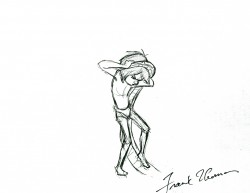 1
1 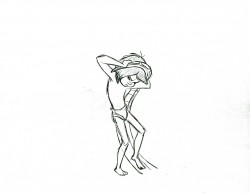 2
2(Click any image to enlarge to full animation paper size.)
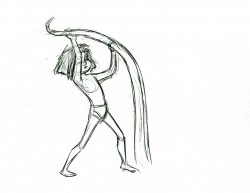 25
25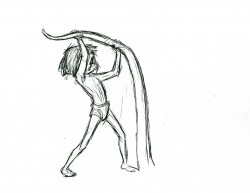 27
27
More to follow next Monday.
Here’s the QT of all the drawings from this scene.
Mowgli & Kaa
Click left side of the black bar to play.
Right side to watch single frame.
Animation Artifacts &Bill Peckmann &Rowland B. Wilson &Story & Storyboards 02 Oct 2009 07:45 am
Troll bd 2
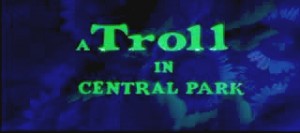 - As promised last week, I’m here to offer another part of the storyboard for Don Bluth‘s film, A Troll in Central Park. As with the initial post, this board was drawn by the extraordinary artist, Rowland B. WIlson. Also as with part one, the material was graciously loaned to me by designer, Bill Peckmann.
- As promised last week, I’m here to offer another part of the storyboard for Don Bluth‘s film, A Troll in Central Park. As with the initial post, this board was drawn by the extraordinary artist, Rowland B. WIlson. Also as with part one, the material was graciously loaned to me by designer, Bill Peckmann.
I don’t have a copy of the film or I’d offer some frame grabs for comparison. Though perhaps we’re better off just accepting Rowland’s work for itself. This film was one of the last of the Sullivan-Bluth films out of the Irish studio. They subsequently moved to Arizona to do Anastasia for Fox.
Looking at these boards I began to wonder what Rowland would have done had he directed a film, himself. Perhaps the closest is the Trans-Siberian Express, Pushkin/Vodka commercial done at Richard Williams’ studio in the 1975. I wouldn’t mind owning a copy of that first spot they did.
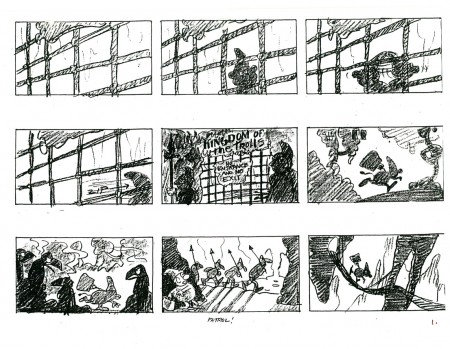 1
1(Click any image to enlarge.)
Next up, we’ll post a stash of Rowland’s models for this film.
Here are a couple of short clips from this film on the Bluth site: #1, #2
Sections of the film are also currently on YouTube. Here’s Part 1.
Animation Artifacts &Bill Peckmann &Rowland B. Wilson &Story & Storyboards 23 Sep 2009 07:37 am
Troll Bd 1
- The animated feature is a funny business. So much work goes into them and so few give back the intended spark that the many creators think they’re investing in the labor. Such a film goes through many incarnations and struggles on its way to the public that it’s a wonder that it even makes it. And when it hits the theaters some jerk like me will dismiss it with a few bad words.
Don Bluth produced and directed as many as 11 feature films between 1982 and 2000. That’s a lot of work, and a lot of talented artists worked with him to get those flms to screens. Not all of them, obviously, were successful. I’ve read about The Pebble and the Penguin, but I don’t remember seeing it though I probably did; and if I don’t remember I may as well not have. Yet how much intensive labor by how many people went into making that film? How many years of work?
A Troll in Central Park is another one of those 11. I’ve seen parts of this film many times over. This is one of those films that I always seem to turn on at exactly the same moment and see the mid-section again and again. I admit that I haven’t seen it to the end. It has a very distinctive look, yet it wasn’t compelling enough for me to stay with it.
I have some of the storyboard sections done by Rowland Wilson, and I want to post them. There’s something to learn from every film fragment and this board offers much. Rowland was such a brilliant artist that it’s worth rummaging through any of his work, and he put a lot into all of it. This board is no exception.
Without further explanation or fanfare, here are 14 pages of board – actually I think they’re thumbnails – which were done by Rowland for A Troll in Central Park. These were given on loan to me by Bill Peckmann. His collection has been a real education for me.
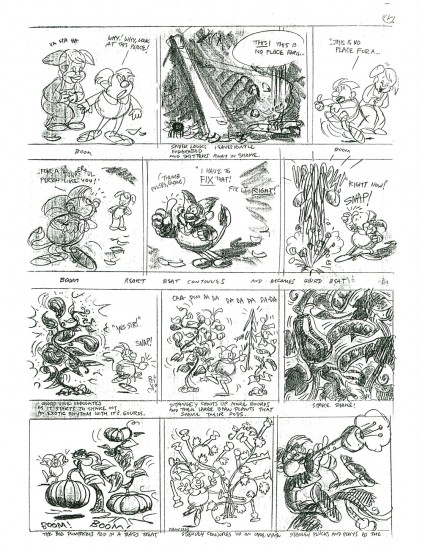 1
1(Click any image to enlarge to a legible size.)
Here are a few character models for this sequence:
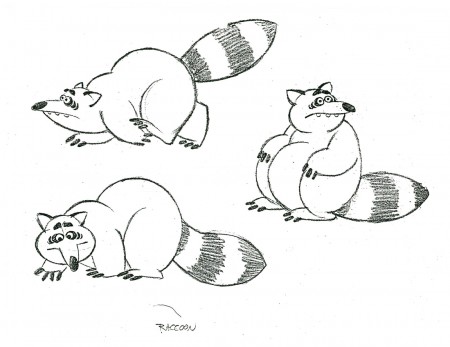
Can an animator have a better design for a racoon?
There’s enormous personality in this character.
And here are some BG Layouts for this sequence:
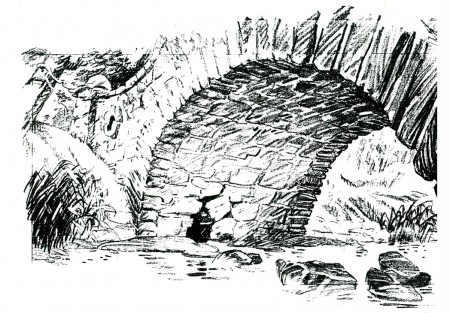 1
1
I’ll put up more of these next week. Many thanks, again, to Bill Peckmann for the loan of this art.
Animation Artifacts &Articles on Animation &Puppet Animation 22 Sep 2009 07:31 am
Coronet George Pal
 - In April 1944, Coronet Magazine printed an article about George Pal and the making of one of his very successful shorts done for Paramount. He had been nominated for seven Oscars for the shorts which included When Tulips Bloom, John Henry and the Inky Poo, and Dr. Seuss’ The 500 Hats of Bartholemew Cubbins, and he was given a special Oscar in 1943 for his puppet work.
- In April 1944, Coronet Magazine printed an article about George Pal and the making of one of his very successful shorts done for Paramount. He had been nominated for seven Oscars for the shorts which included When Tulips Bloom, John Henry and the Inky Poo, and Dr. Seuss’ The 500 Hats of Bartholemew Cubbins, and he was given a special Oscar in 1943 for his puppet work.
The short featured is Jasper Goes Hunting. This is one of the last of the films featuring this character, a holdover from the racist days of yore. Sort of a puppet version of Harman-Ising’s Bosco.
Pal’s style animated puppetry involved lots of replacement parts. If you wanted to move an arm, you had to create a dozen arms which would be replaced from frame to frame. It’s a very time consuming process and offers lots of opportunity of messing up a shot and having to start over.
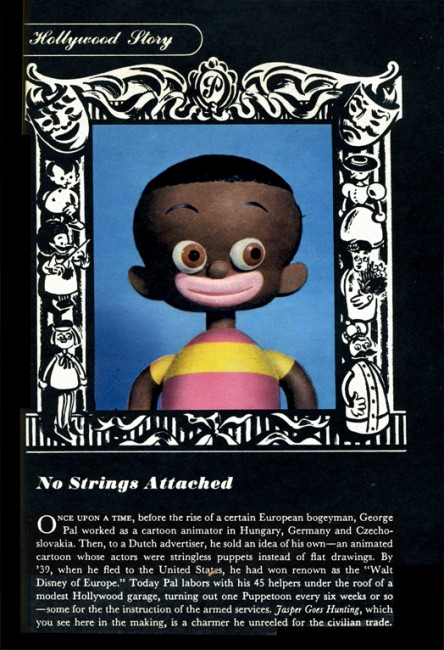
(Click any image to enlarge.)
Note that Jerry Beck on Cartoon Brew just recently directed us to an auction
of many of George Pal’s puppets. Some of the puppets for the film featured
in Coronet are among those up for sale. This is the link to the auction.























